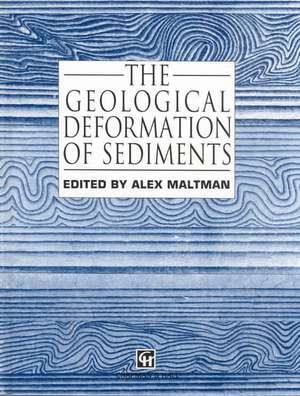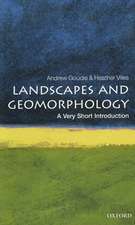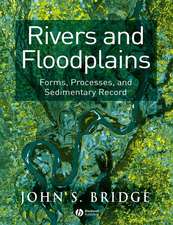The Geological Deformation of Sediments
Editat de A. Maltmanen Limba Engleză Hardback – 31 aug 1994
| Toate formatele și edițiile | Preț | Express |
|---|---|---|
| Paperback (1) | 1234.32 lei 6-8 săpt. | |
| SPRINGER NETHERLANDS – 5 oct 2012 | 1234.32 lei 6-8 săpt. | |
| Hardback (1) | 1233.06 lei 6-8 săpt. | |
| SPRINGER NETHERLANDS – 31 aug 1994 | 1233.06 lei 6-8 săpt. |
Preț: 1233.06 lei
Preț vechi: 1503.73 lei
-18% Nou
Puncte Express: 1850
Preț estimativ în valută:
235.98€ • 243.78$ • 196.39£
235.98€ • 243.78$ • 196.39£
Carte tipărită la comandă
Livrare economică 25 martie-08 aprilie
Preluare comenzi: 021 569.72.76
Specificații
ISBN-13: 9780412405907
ISBN-10: 0412405903
Pagini: 362
Ilustrații: XV, 362 p.
Dimensiuni: 210 x 297 x 22 mm
Greutate: 0.89 kg
Ediția:1994
Editura: SPRINGER NETHERLANDS
Colecția Springer
Locul publicării:Dordrecht, Netherlands
ISBN-10: 0412405903
Pagini: 362
Ilustrații: XV, 362 p.
Dimensiuni: 210 x 297 x 22 mm
Greutate: 0.89 kg
Ediția:1994
Editura: SPRINGER NETHERLANDS
Colecția Springer
Locul publicării:Dordrecht, Netherlands
Public țintă
ResearchCuprins
1 Introduction and overview.- 1.1 General considerations.- 1.2 Mechanical aspects.- 1.3 Causes of deformation.- 1.4 Mélanges as a case history.- 2 Mechanical principles of sediment deformation.- 2.1 Introduction.- 2.2 Mechanics of particulate media in theory and experiment.- 2.3 Natural stress, strain and pore pressure.- 2.4 Conclusions.- 3 Glacial deformation.- 3.1 Introduction.- 3.2 Subglacial conditions.- 3.3 Stresses arising from overlying ice.- 3.4 Sediment properties.- 3.5 The sediment transport system: production, alteration and loss.- 3.6 Models of sediment properties and deformation.- 3.7 Basal processes as a control on deformation.- 3.8 Effects of deformation.- 3.9 Preservation of features.- 3.10 Other types of glacial deformation.- 3.11 Conclusion.- 4 Sedimentary deformational structures.- 4.1 Introduction.- 4.2 Principles of physical disturbance.- 4.3 Physical deformation structures.- 4.4 Conclusion.- 5 Mass movements.- 5.1 Introduction.- 5.2 Falls.- 5.3 Fluidal flows.- 5.4 Flows with plastic behavior.- 5.5 Slumps.- 5.6 Slides.- 5.7 Creep.- 6 Tectonic deformation: stress paths and strain histories.- 6.1 Introduction.- 6.2 Stress paths during burial and up-lift of sediments in basins.- 6.3 Stress paths associated with deformation in accretionary prisms.- 6.4 Conclusions.- 7 Fluids in deforming sediments.- 7.1 Introduction.- 7.2 Some basic hydrogeological concepts.- 7.3 Fluid sources and the nature of the tectonic processes driving fluid flow.- 7.4 Control of lithology and burialrelated consolidation on the permeability of sedimentary units.- 7.5 Permeability variations due to deformation in active tectonic systems: fractures, faults and gouge.- 7.6 Permeability changes at low effective stresses.- 7.7 Effect of deformation on the tortuosity of flow paths atdifferent scales.- 7.8 Discussion: transience and the intimate coupling of hydrogeological and tectonic processes.- 8 Sediment deformation, dewatering and diagenesis: illustrations from selected mélange zones.- 8.1 Introduction.- 8.2 Progressive deformation and dewatering in the Nankai accretionary prism.- 8.3 Progressive deformation of coherent sediments in the Kodiak accretionary prism.- 8.4 Progressive deformation of mélange terranes in the Kodiak accretionaryprism.- 8.5 Deformation and fluid evolution in an accretionary sequence in western Washington.- 8.6 Conclusions.- 9 Deformation structures preserved in rocks.- 9.1 Introduction.- 9.2 Techniques of examination.- 9.3 Microfabrics.- 9.4 Micro- to macroscopic structures.- 9.5 Macro- to mesoscopic structures.- 9.6 Recognition of sediment deformation structures.- Appendix: List of symbols.- References.













